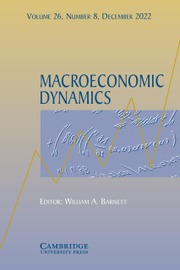Article contents
SOCIAL LEARNING ABOUT CONSUMPTION
Published online by Cambridge University Press: 28 September 2015
Abstract
This paper applies a social learning model to the optimal consumption rule of Allen and Carroll [Macroeconomic Dynamics 5(2001), 255–271] and delivers convincing convergence dynamics toward the optimal rule. These findings constitute a significant improvement over previous results in the literature, in terms of both speed of convergence and parsimony of the learning model. The learning model exhibits several appealing features: it is frugal, is easy to apply to a various range of learning objectives, and requires few procedures and little information. Particular care is given to behavioral interpretation of the modeling assumptions in light of evidence from the fields of psychology and social science. Our results highlight the need to depart from the genetic metaphor, and account for intentional decision-making, based on agents' relative performances. By contrast, we show that convergence is strongly hindered by exact imitation processes, or random exploration mechanisms, which are usually assumed when modeling social learning behavior. Our results suggest a method for modeling bounded rationality, which could be interestingly tested in a wide range of economic models with adaptive dynamics.
Information
- Type
- Articles
- Information
- Copyright
- Copyright © Cambridge University Press 2015
References
REFERENCES
- 2
- Cited by

